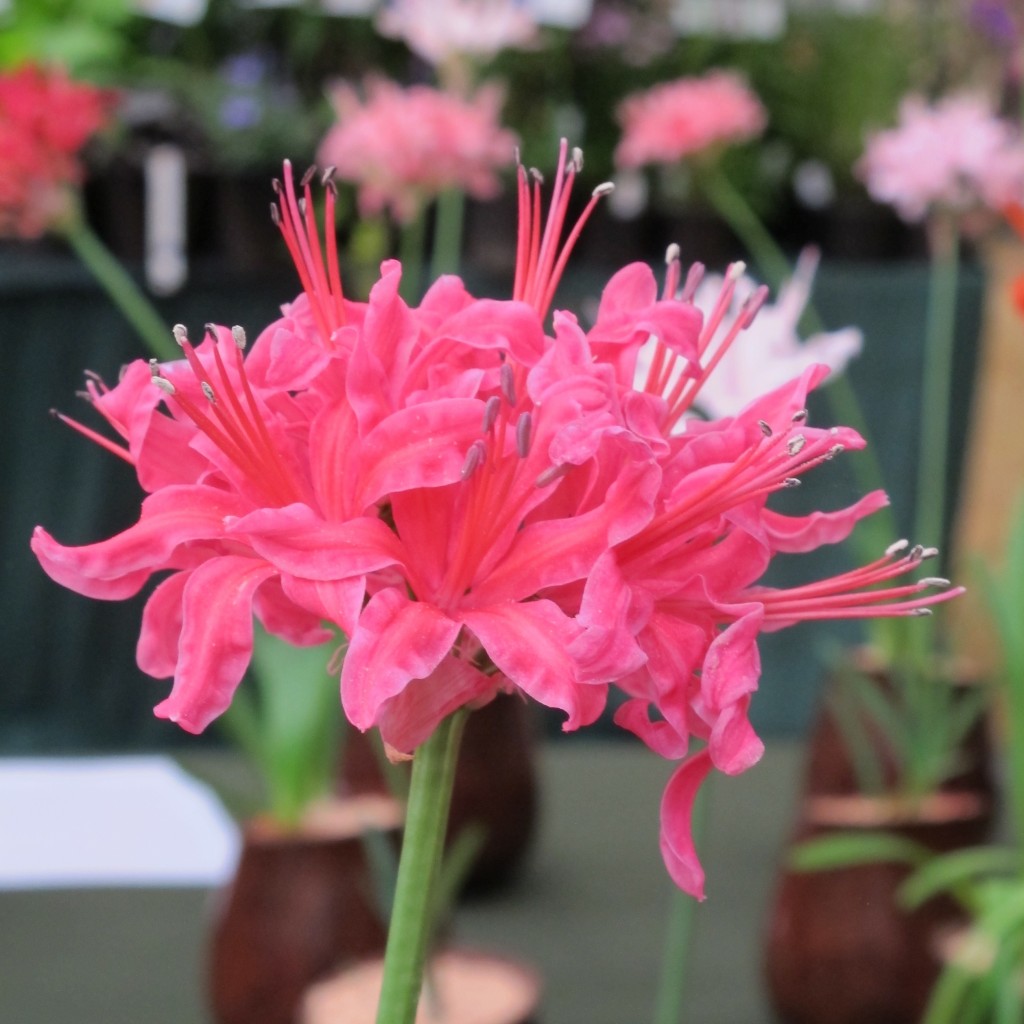 Having a lovely greenhouse may not have worked out quite the way I’d like. As you may know ( from previous griping) the Best Beloved has filled it with edibles – sweet peppers, tomatoes and aubergines mainly. However I do manage to reclaim some space for my twenty or so nerines and they produce spectacular flowers in September and October in shades of pink, salmon and almost red. They’re surreal, agapanthus with a housewives’ perm. And they wrinkle up their petals like ribbons on a birthday present, shrugging off heavy rain and sparkling in the autumn light. Better still they perform as the year wanes, with a decadent abandon I admire as much as an Ascot fascinator in the Royal enclosure. You see I’m a hedonist at heart.
Having a lovely greenhouse may not have worked out quite the way I’d like. As you may know ( from previous griping) the Best Beloved has filled it with edibles – sweet peppers, tomatoes and aubergines mainly. However I do manage to reclaim some space for my twenty or so nerines and they produce spectacular flowers in September and October in shades of pink, salmon and almost red. They’re surreal, agapanthus with a housewives’ perm. And they wrinkle up their petals like ribbons on a birthday present, shrugging off heavy rain and sparkling in the autumn light. Better still they perform as the year wanes, with a decadent abandon I admire as much as an Ascot fascinator in the Royal enclosure. You see I’m a hedonist at heart.
The nerines I grow in the greenhouse are too tender to grow outside having been bred from Nerine sarniensis, a wider leaved bulb also knows as the Guernsey lily. Sarnia was the Roman name for Guernsey and it’s said that bulbs were washed up on the shores of Guernsey in the mid-17th century. They became naturalised there, due to the benign climate of the Channel Islands, and were exported as cut flowers. They do last incredibly well in water although I cannot bear to pick any of mine. However large country houses made full use of them in late-autumn as cut flower picked from the greenhouses. Exbury Gardens near Southampton now have the largest collection of N. sarniensis in the world.
Despite being called the Guernsey lily, N. sarniensis comes from the West Cape Province of South Africa, an area that gets winter rainfall followed by a dry summer. It’s the most glamorous nerine, with well-formed flowers that show ‘gold dust’, a shimmer known as coruscation. A bright-pink flower seems to radiate a blue shimmer, like a gas jet. This device reflects sunlight away from the pigment-packed petals, because South Africa has high light levels. However it’s not a tropical paradise. It’s a rugged country and when the wind cuts up from the south pole it can feel as bleak as Blackpool in May. South Africa gets seasonal rain so although Cape Town only gets 18 inches per year, January can deliver six inches alone. As a result South African flora has evolved to enjoy a wet growing season and crocosmias and kniphofias thrive in a wet British summer. Watercourses on the sides of South African hills, are packed with plants up to their knees.
My nerines have thrive on neglect but mostly flower for me. The secret is to keep them in leaf for as long as possible after flowering with the aid of a frost-breaking heater. In early summer they come outside, evicted by the Best Beloved, and go somewhere dry. Then we start them off again in early August. It may not be text book treatment, but it works for me. Cotswold Garden Flowers sell quite a few because Bob Brown is an active member of the Nerine and Amaryllid Society as I am too. They organise bulb swaps and visits among many other things.
Our garden nerine, N. bowdenii, comes from the Eastern Cape. They have the other side of the coin and enjoy summer rainfall and a dry winter and that makes them suitable for British gardens. The flowers don’t have any iridescence and they do not come in a wide colour range, just in shades of pink and white, but they still contribute much to the autumn garden. Many tuck theirs close to the house or the greenhouse wall and just allow them to get on with it, for these autumn lovelies seem to enjoy growing cheek by jowl – their necks above the soil line. Others disagree and space theirs out in the garden. Mine fail to flower in the wonderfully named village of Cold Aston, when given freedom and space.
The species N. bowdenii takes its name from a Mr Athelstan Cornish-Bowden who sent bulbs from the King’s William Town area of the Eastern Cape to his mother in Devon in the early 1900s. Dutch bulb companies sell these very cheaply because the bulbs are planted as a cut flower.
Breeders have hybridised the more-tender but infinitely more colourful Guernsey lily (N. sarniensis) with the run-of-the-mill pink, hardier garden form of N. bowdenii. The most well known hybrid is ‘Zeal Giant’ bred by the late Terry Jones of Zeal Monachorum in Devon. This impressive nerine has bright-pink-to-magenta flowers held on strong stems, but sadly it has not proved hardy here even grown against the south-facing wall. It’s now in a pot.
I love nerines for their ability to put their heads above the parapet in autumn. And I can guarantee that some in the greenhouse will be in flower on the greyest, filthiest November day defying the elements. By then the Best Beloved’s edibles will have gone – so I shall have the last word horticulturally speaking!











